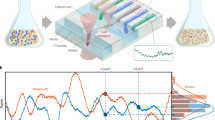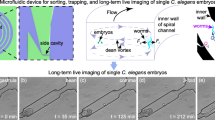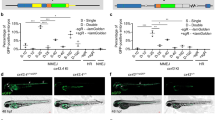Abstract
For the nematode Caenorhabditis elegans, automated selection of animals of specific genotypes from a mixed pool has become essential for genetic interaction or chemical screens. To date, such selection has been accomplished using specialized instruments. However, access to such dedicated equipment is not common. Here we describe live animal fluorescence-activated cell sorting (laFACS), a protocol for automatic selection of live first larval stage (L1) animals using a standard FACS system. We show that FACS can be used for the precise identification of GFP-expressing and non-GFP-expressing subpopulations and can accomplish high-speed sorting of live animals. We have routinely collected 100,000 or more homozygotes from a mixed starting population within 2 h, and with greater than 99% purity. The sorted animals continue to develop normally, making this protocol ideally suited for the isolation of terminal mutants for use in genetic interaction or chemical genetic screens.
This is a preview of subscription content, access via your institution
Access options
Subscribe to this journal
Receive 12 print issues and online access
$259.00 per year
only $21.58 per issue
Buy this article
- Purchase on Springer Link
- Instant access to full article PDF
Prices may be subject to local taxes which are calculated during checkout




Similar content being viewed by others
References
Brenner, S. The genetics of Caenorhabditis elegans. Genetics 77, 71–94 (1974).
Moerman, D.G. & Barstead, R.J. Towards a mutation in every gene in Caenorhabditis elegans. Brief. Funct. Genomic Proteomic 7, 195–204 (2008).
Kamath, R.S. et al. Systematic functional analysis of the Caenorhabditis elegans genome using RNAi. Nature 421, 231–237 (2003).
Reboul, J. et al. C. elegans ORFeome version 1.1: experimental verification of the genome annotation and resource for proteome-scale protein expression. Nat. Genet. 34, 35–41 (2003).
Lamesch, P. et al. C. elegans ORFeome version 3.1: increasing the coverage of ORFeome resources with improved gene predictions. Genome Res. 14, 2064–2069 (2004).
Mohler, W.A. & Isaacson, A.B. Imaging embryonic development in Caenorhabditis elegans. Cold Spring Harb. Protoc. published online, doi:10.1101/pdb.top71 (2010).
Gunsalus, K.C. et al. Predictive models of molecular machines involved in Caenorhabditis elegans early embryogenesis. Nature 436, 861–865 (2005).
Sönnichsen, B. et al. Full-genome RNAi profiling of early embryogenesis in Caenorhabditis elegans. Nature 434, 462–469 (2005).
Green, R.A. et al. A high-resolution C. elegans essential gene network based on phenotypic profiling of a complex tissue. Cell 145, 470–482 (2011).
Kemphues, K. Essential genes. in WormBook (ed. The C. elegans Research Community) doi:10.1895/wormbook.1.57.1 (2005).
Pulak, R. Techniques for analysis, sorting, and dispensing of C. elegans on the COPAS flow-sorting system. Methods Mol. Biol. (Clifton, NJ) 351, 275–286 (2006).
Dupuy, D. et al. Genome-scale analysis of in vivo spatiotemporal promoter activity in Caenorhabditis elegans. Nat. Biotechnol. 25, 663–668 (2007).
Doitsidou, M., Flames, N., Lee, A.C., Boyanov, A. & Hobert, O. Automated screening for mutants affecting dopaminergic-neuron specification in C. elegans. Nat. Methods 5, 869–872 (2008).
Fernandez, A.G., Mis, E.K., Bargmann, B.O., Birnbaum, K.D. & Piano, F. Automated sorting of live C. elegans using laFACS. Nat. Methods 7, 417–418 (2010).
Stoeckius, M. et al. Large-scale sorting of C. elegans embryos reveals the dynamics of small RNA expression. Nat. Methods 6, 745–751 (2009).
Fernandez, A.G. & Piano, F. MEL-28 is downstream of the Ran cycle and is required for nuclear-envelope function and chromatin maintenance. Curr. Biol. 16, 1757–1763 (2006).
Galy, V., Askjaer, P., Franz, C., Lopez-Iglesias, C. & Mattaj, I.W. MEL-28, a novel nuclear-envelope and kinetochore protein essential for zygotic nuclear-envelope assembly in C. elegans. Curr. Biol. 16, 1748–1756 (2006).
Ausubel, F.M. et al. (eds.) Medium preparation and bacteriological tools. In Short Protocols in Molecular Biology, 5th edn., Vol. 1. 1–8 (Wiley, 2002).
Edgley, M.L. & Riddle, D.L. LG II balancer chromosomes in Caenorhabditis elegans: mT1(II;III) and the mIn1 set of dominantly and recessively marked inversions. Mol. Genet. Genomics 266, 385–395 (2001).
Edgley, M.K., Baillie, D.L., & Rose, A.M. Genetic balancers. in WormBook (ed. The C. elegans Research Community) doi:10.1895/wormbook.1.89.1 (2006).
Acknowledgements
We thank E. Andersen, D.G. Moerman and R. Waterston for sharing unpublished data; P.-L. Ip, J. Lucas and K. Erikson for technical assistance; and S.D. Weatherbee for critically reviewing the manuscript. Funding sources included the Eunice Kennedy Shriver National Institute of Child Health and Human Development (NICHD; R01HD046236) and the National Human Genome Research Institute (NHGRI; U01 HG004276) to F.P., the US National Institutes of Health (NIH; R01GM078279-01) to K.D.B. and the National Science Foundation (0827858) and Fairfield University start-up funds to A.G.F. Nematode strains were provided by the Caenorhabditis Genetics Center, which is funded by the NIH National Center for Research Resources (NCRR).
Author information
Authors and Affiliations
Contributions
F.P. and A.G.F. initially developed the idea; B.O.R.B. and A.G.F. developed the FACS conditions; and F.P., A.G.F., B.O.R.B., E.K.M., M.L.E. and K.D.B. contributed to the realization of the protocol.
Corresponding authors
Ethics declarations
Competing interests
The authors declare no competing financial interests.
Rights and permissions
About this article
Cite this article
Fernandez, A., Bargmann, B., Mis, E. et al. High-throughput fluorescence-based isolation of live C. elegans larvae. Nat Protoc 7, 1502–1510 (2012). https://doi.org/10.1038/nprot.2012.084
Published:
Issue Date:
DOI: https://doi.org/10.1038/nprot.2012.084
This article is cited by
-
Circular Estimate Method (CEM) - a Simple Method to Estimate Caenorhabditis elegans Culture Densities in Liquid Medium
Biological Procedures Online (2019)
-
LED based real-time survival bioassays for nematode research
Scientific Reports (2018)
-
Counting Caenorhabditis elegans: Protocol Optimization and Applications for Population Growth and Toxicity Studies in Liquid Medium
Scientific Reports (2018)
Comments
By submitting a comment you agree to abide by our Terms and Community Guidelines. If you find something abusive or that does not comply with our terms or guidelines please flag it as inappropriate.



